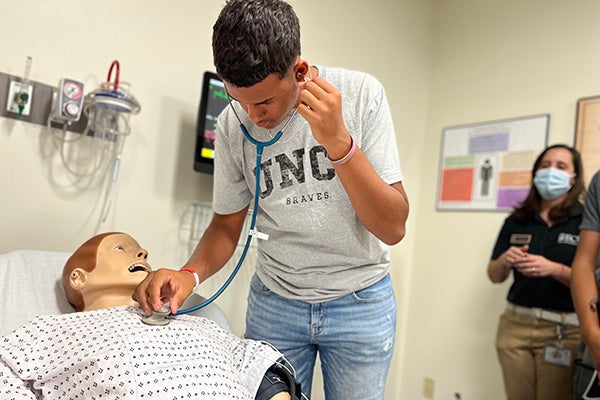Lumbee Tribe STEM students visit ECU
High school students from North Carolina’s largest state-recognized Indian tribe — and who have particular interest in science, technology, engineering and math fields — visited East Carolina University’s Health Sciences Campus on July 13 to get a first-hand look at what life as a Pirate health sciences major might look like.
The STEM-focused students visited a cluster of post-secondary schools in eastern North Carolina — stopping at Methodist and Campbell universities — before spending an entire day on ECU’s Health Sciences Campus. They toured ECU’s Brody School of Medicine, Health Sciences Student Center, College of Nursing, School of Dental Medicine and met with the ECU directors of the North Carolina Agromedicine Institute.

Louae Feliciano, a high school student from Lumberton, North Carolina, listens to simulated chest sounds on a mannequin at the Brody School of Medicine. (ECU photos by Benjamin Abel)
The tour was organized by Project 3C (Community, College and Career), a collaboration between the Lumbee Tribe of North Carolina, Public Schools of Robeson County, Robeson Community College, and the University of North Carolina at Pembroke. Grant funding for the project was provided by the Native Youth Community Project which is administered by the U.S. Department of Education.
The Lumbee Tribe’s 55,000 members live primarily in the southern North Carolina counties of Cumberland, Hoke, Robeson and Scotland.
“These community projects are geared towards poverty-stricken areas — low income, very rural — which is what Robeson County is. We actually serve the four counties for the Lumbee Tribe service area, and I think we’ve got representatives for at least each county,” said Samantha Brayboy, Project 3C’s director and a member of the Lumbee Tribe.
Brayboy said the stop at ECU was a perfect fit for the students.
“The short-term goal is to increase their knowledge of the opportunities that are available, through STEM, and give them a basic introduction of what is available outside of our small service area. Hopefully we can increase the number of American Indians that are represented in STEM overall, because our total population for the entire nation, is under one percent,” Brayboy said.
To be accepted into the program, students were required to write an essay about why they wanted to pursue a career in the sciences before being accepted.
“The long-term objective of the camp,” Brayboy said, “is to introduce students to opportunities and skills outside of the tribe’s traditional footprint that they can bring back to their communities the benefit the tribe as a whole.”
Rylan Oxendine’s family is involved in medicine — his mother is a surgical technician, his cousin is a doctor and another cousin is a firefighter. The Maxton, North Carolina, high school student was impressed by the educational opportunities available on ECU’s Health Science Campus and has ECU as one of his three top schools in mind after graduation.

Rylan Oxendine, of Maxton, North Carolina, was one of several students to visit the Brody School of Medicine on July 13.
“I’ve always wanted a career in engineering and the medical field,” Oxendine said. “I’m also interested in the physician assistant program. So, hearing them talk about that was really great.”
Dr. Ann Bell is a member of the Lumbee Tribe and the only Native American member of ECU’s College of Nursing, where she serves as a clinical assistant professor. Bell believes that programs like Project 3C will give Lumbee students an opportunity to get a glimpse of the possibilities that North Carolina offers — particularly the educational opportunities at ECU.
“It’s very important that they see outside of Robeson County; that they see other campuses. Of course, this summer, they’re getting exposed to UNC-Pembroke,” Bell said, but stressed the importance of students from the tribe being able to experience opportunities “beside what’s in their backyard.”
Bell also recognizes the important role that she plays a mentor to aspiring Native American college students.
“It’s important for me to be here, for them to see someone that looks like them from home is very important,” she said, “so they can say, ‘I can do this. I can make it and I belong here.’”
For some students, the value in school visits is as much learning what they don’t want to do as much as a path that is more in line with their skills and interests.
“I used to really want to go into the medical field,” said Emma Locklear, of Lumberton. “But now it’s Plan B. My Plan A is to go to law school.”
As important as it is for Native American students to see the opportunities available to them at large universities like ECU, it is just as important for Native students to enrich the Pirate student body with their unique experiences, culture and worldview.
“I was really proud to see so many of the Indigenous high schoolers from my community here at ECU and to see that they are interested in the STEM fields. We need our youth to see they have access to educational opportunities and programs that will allow them to help the community and tribe,” said Aleshia Hunt, ECU’s student government association advisor and a member of the Lumbee Tribe.